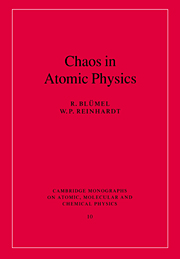Book contents
- Frontmatter
- Contents
- Preface
- 1 Introduction
- 2 Chaos: tools and concepts
- 3 Chaos in classical mechanics
- 4 Chaos in quantum mechanics
- 5 The kicked rotor: paradigm of chaos
- 6 Microwave-driven surface state electrons
- 7 The hydrogen atom in a strong microwave field
- 8 The kicked hydrogen atom
- 9 Chaotic scattering with CsI molecules
- 10 The helium atom
- 11 Chaos in atomic physics: state of the art and research directions
- References
- Index
3 - Chaos in classical mechanics
Published online by Cambridge University Press: 14 September 2009
- Frontmatter
- Contents
- Preface
- 1 Introduction
- 2 Chaos: tools and concepts
- 3 Chaos in classical mechanics
- 4 Chaos in quantum mechanics
- 5 The kicked rotor: paradigm of chaos
- 6 Microwave-driven surface state electrons
- 7 The hydrogen atom in a strong microwave field
- 8 The kicked hydrogen atom
- 9 Chaotic scattering with CsI molecules
- 10 The helium atom
- 11 Chaos in atomic physics: state of the art and research directions
- References
- Index
Summary
Poincaré (1892, reprinted (1993)) was the first to appreciate that exponential sensitivity in mechanical systems can lead to exceedingly complicated dynamical behaviour. Surprisingly, complicated systems are not necessary for chaos to emerge. In fact, chaos can be found in the simplest dynamical systems. Well known examples are the driven pendulum (Chirikov (1979), Baker and Gollub (1990)), the double pendulum (Shinbrot et al. (1992)), and the classical versions of the hydrogen atom in a strong magnetic (Friedrich and Wintgen (1989)) or microwave (Casati et al. (1987)) field.
In general it is not possible to understand the spectra and wave functions of highly excited atoms and molecules without reference to their classical dynamics. The correspondence principle, e.g., assumes knowledge of the classical Hamiltonian as a starting point. Since the Lagrangian and Hamiltonian formulations of classical mechanics provide the most natural bridge to quantum mechanics, we start this chapter with a brief review of elementary concepts in Lagrangian and Hamiltonian mechanics (see Section 3.1). The double pendulum, an example of a classically chaotic system, is investigated in Section 3.2. This is also the natural context in which to introduce the idea of Poincaré sections. With the help of Poincaré sections we can reduce the continuous motion of a mechanical system to a discrete mapping. This is essential for visualization and analysis of a chaotic system. A discussion of integrability and chaos in Section 3.3 concludes Chapter 3.
- Type
- Chapter
- Information
- Chaos in Atomic Physics , pp. 64 - 82Publisher: Cambridge University PressPrint publication year: 1997

